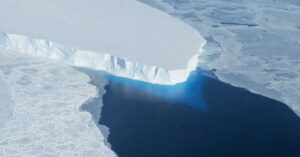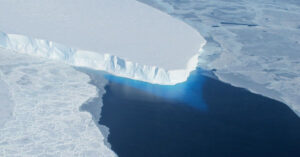
130-Year-Old Lake Michigan Shipwreck Found Off The Coast of Algoma, Wisconsin
September 22, 2024
MV Ruby Ship Loaded With 20,000 Tonnes Of Russian Explosives Runs Aground Off Norway
September 23, 2024

The widest glacier on earth, the Thwaites Glacier, is melting at a faster pace than expected due to global warming. This discovery has shocked scientists and researchers around the world.
If the glacier melts entirely, it could be catastrophic, as sea levels would rise tremendously, and many parts of coastal countries like Bangladesh and other islands would be completely submerged.
Due to this fact, this glacier in Antarctica is also called the Doomsday Glacier. It was found recently, in 2018 and since then has been a centre of research, leading to the creation of the International Thwaites Glacier Collaboration.
The glacier, almost the size of Florida, measures 120 km across and is 2 km high. A portion of it lies on bedrock, and its other parts float over the waters, with the remaining half submerged.
However, tidal forces lift the sea part of the glacier. Hence, warm water can enter between the glacier’s underside and bedrock, speeding up the melting process.
If the glacier melts completely, a possibility in the coming century, the rise in water levels is unimaginable.
Thwaites is over 2 km thick in some places, and it acts as a cork. If it collapses, sea levels will rise by 26 inches or 65 cm. To put it into perspective, oceans presently rise 4.6 mm annually.
It also acts as an anchor that holds back the West Antarctic Ice Sheet. If it melts, the entire sheet could collapse, raising sea levels by 3.3 m!
The glacier has been retreating for over eight decades, but the process has sped up in the last three decades, according to Rob Larter, a marine geophysicist who contributed to the research regarding Thwaites.
The world is in danger until something is done to prevent or slow down this process. Scientists are trying but they don’t know what to do.
Though some computer models suggest a decrease in greenhouse gas emissions per the 2015 Paris Agreement might mitigate the retreat of the glacier, the probability remains grim, per a report by the International Thwaites Glacier Collaboration.
Scientists from the British Antarctic Survey, the U.S. National Science Foundation, and the UK’s Natural Environment Research Council are involved in this project.
Though there is regular snowfall in the region which makes up for ice loss, Michelle Maclennan, a climate scientist at the University of Colorado said there is an imbalance. The ice loss is more than what the snowfall can compensate for, she added.
References: WION, Economic Times, The Hindu Business Line
Doomsday Glacier Melting Faster, Sea Level Rise Could Drown Bangladesh & Coastal Nations appeared first on Marine Insight – The Maritime Industry Guide
Source: Maritime Shipping News


